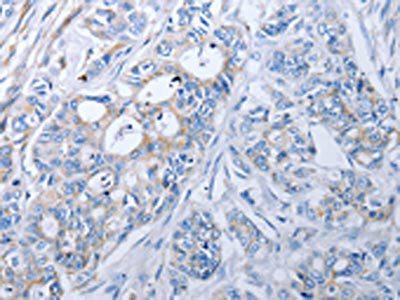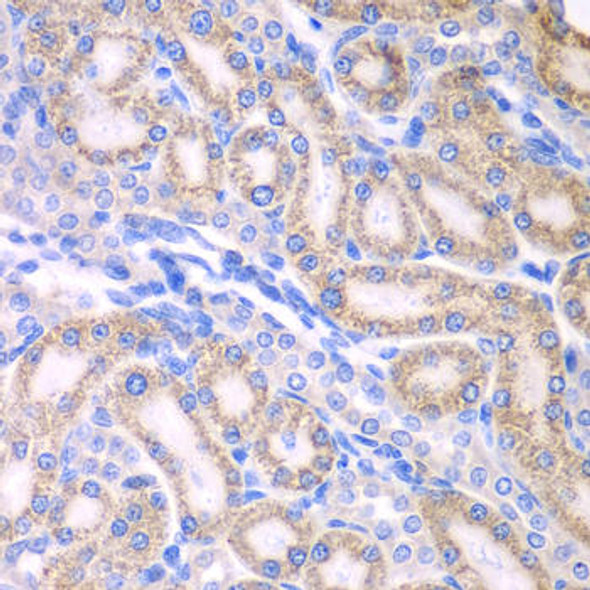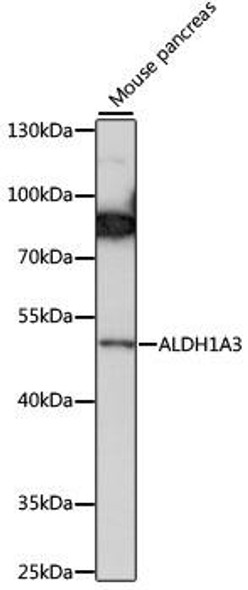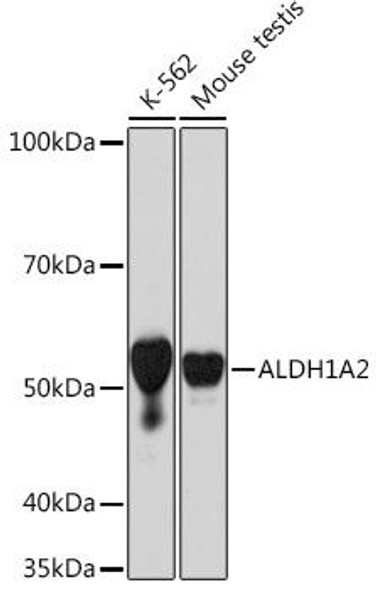Description
| Antibody Name: | ALDH1A1/ALDH1A2/ALDH1A3 Antibody (PACO13833) |
| Antibody SKU: | PACO13833 |
| Size: | 50ul |
| Host Species: | Rabbit |
| Tested Applications: | ELISA, WB, IHC |
| Recommended Dilutions: | ELISA:1:1000-1:5000, WB:1:500-1:1000, IHC:1:20-1:50 |
| Species Reactivity: | Human |
| Immunogen: | Fusion protein of human ALDH1A1/ALDH1A2/ALDH1A3 |
| Form: | Liquid |
| Storage Buffer: | -20°C, pH7.4 PBS, 0.05% NaN3, 40% Glycerol |
| Purification Method: | Antigen affinity purification |
| Clonality: | Polyclonal |
| Isotype: | IgG |
| Conjugate: | Non-conjugated |
 | Gel: 10%SDS-PAGE, Lysate: 30 μg, Lane: Human liver cancer tissue, Primary antibody: PACO13833(ALDH1A1/ALDH1A2/ALDH1A3 Antibody) at dilution 1/450, Secondary antibody: Goat anti rabbit IgG at 1/8000 dilution, Exposure time: 1 minute. |
 | The image on the left is immunohistochemistry of paraffin-embedded Human colon cancer tissue using PACO13833(ALDH1A1/ALDH1A2/ALDH1A3 Antibody) at dilution 1/40, on the right is treated with fusion protein. (Original magnification: x200). |
| Background: | This protein belongs to the aldehyde dehydrogenase family of proteins. The product of this gene is an enzyme that catalyzes the synthesis of retinoic acid, (RA) from retinaldehyde. Retinoic acid, the active derivative of vitamin A (retinol), is a hormonal signaling molecule that functions in developing and adult tissues. The studies of a similar mouse gene suggest that this enzyme and the cytochrome CYP26A1, concurrently establish local embryonic retinoic acid, levels which facilitate posterior organ development and prevent spina bifida. Four transcript variants encoding distinct isoforms have been identified for this gene. |
| Synonyms: | Aldehyde dehydrogenase 1 family, member A1/2/3 |
| UniProt Protein Function: | ALDH1A1: Binds free retinal and cellular retinol-binding protein- bound retinal. Can convert/oxidize retinaldehyde to retinoic acid. Belongs to the aldehyde dehydrogenase family. |
| UniProt Protein Details: | Protein type:GAPs, Ras; EC 1.2.1.36; GAPs; Cofactor and Vitamin Metabolism - retinol; Apoptosis; Oxidoreductase Chromosomal Location of Human Ortholog: 9q21.13 Cellular Component: cytoplasm; cytosol Molecular Function:aldehyde dehydrogenase (NAD) activity; androgen binding; 3-chloroallyl aldehyde dehydrogenase activity; benzaldehyde dehydrogenase (NAD+) activity; retinal dehydrogenase activity Biological Process: retinol metabolic process; xenobiotic metabolic process; aldehyde metabolic process; ethanol oxidation |
| NCBI Summary: | The protein encoded by this gene belongs to the aldehyde dehydrogenase family. Aldehyde dehydrogenase is the next enzyme after alcohol dehydrogenase in the major pathway of alcohol metabolism. There are two major aldehyde dehydrogenase isozymes in the liver, cytosolic and mitochondrial, which are encoded by distinct genes, and can be distinguished by their electrophoretic mobility, kinetic properties, and subcellular localization. This gene encodes the cytosolic isozyme. Studies in mice show that through its role in retinol metabolism, this gene may also be involved in the regulation of the metabolic responses to high-fat diet. [provided by RefSeq, Mar 2011] |
| UniProt Code: | P00352 |
| NCBI GenInfo Identifier: | 118495 |
| NCBI Gene ID: | 216 |
| NCBI Accession: | P00352.2 |
| UniProt Related Accession: | P00352 |
| Molecular Weight: | ~ 50-55kDa |
| NCBI Full Name: | Retinal dehydrogenase 1 |
| NCBI Synonym Full Names: | aldehyde dehydrogenase 1 family member A1 |
| NCBI Official Symbol: | ALDH1A1 |
| NCBI Official Synonym Symbols: | ALDC; ALDH1; HEL-9; HEL12; PUMB1; ALDH11; RALDH1; ALDH-E1; HEL-S-53e |
| NCBI Protein Information: | retinal dehydrogenase 1 |
| UniProt Protein Name: | Retinal dehydrogenase 1 |
| UniProt Synonym Protein Names: | ALDH-E1; ALHDII; Aldehyde dehydrogenase family 1 member A1; Aldehyde dehydrogenase, cytosolic |
| Protein Family: | Retinal dehydrogenase |
| UniProt Gene Name: | ALDH1A1 |
| UniProt Entry Name: | AL1A1_HUMAN |






